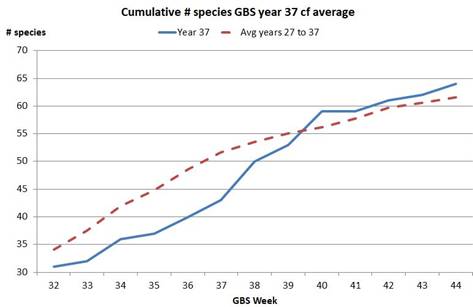Yes, obviously having a site that includes water features of significance (creeks, lakes or ponds), is a major component to greatly increase the potential species
count, over the majority of sites that don’t. However over the history of the GBS there has most likely been at least one or two GBS sites per year that have this facility. For what it is worth Nankeen Night Heron certainly had been reported. Within the first
21 years it was only GBS recorded in years 4 & 8, (as mentioned on page 111 of The GBS Report), we are now in year 37 and it is very unlikely that it had not got further records since then (other than yours). Over the years I too have had water birds: ducks,
pelican, ibis, cormorants, even a Sea-Eagle observed within (as in over) my home. Indeed in the early years I had Maned Ducks frequently on my GBS, although I never saw them within the GBS Site. All records were heard whilst flying over at night.
That however is a different issue from the one that Martin raised, which is about accumulation curves over time. I was simply supporting that the form of Martin’s
graph is an entirely typical outcome of these surveys, even independent of the scales of either the x or y axis.
No part of my analysis included eBird (I don’t even think it existed then).
Philip
From: John Harris [
Sent: Tuesday, 31 October, 2017 8:15 AM
To: Philip Veerman; 'COG List'
Subject: Re: [canberrabirds] Cumulative GBS species
The influx of new species is probably due in part to me. I was slack this year in reporting and it was months before I got around to transferring my written GBS lists to eBird. My lists would have contained birds like Nankeen Night Heron
which may not yet have been reported. While Philip is right that rural sites are obviously more productive than sites on the middle of suburbia, a few of us are privileged to live on an urban site with water within our 100 metre radius.
I back onto Ginninderra Creek Nicholls below Percival Hill which is the flight corridor between the northern lakes and ponds so I get to report spoonbills etc in my GBS. Also from time to time almost everything which comes down from Percival
Hill.
I chose this block purposely when down sizing. So it is observers like me who contribute some of the more unusual birds to the GBS survey
From: Philip Veerman <>
Sent: Monday, October 30, 2017 2:43:31 PM
To: 'COG List'
Subject: RE: [canberrabirds] Cumulative GBS species
Sort of similar to Figure 14 of The GBS Report (which of course pools data for all GBS charts). Martin’s graph is a usual representation of the trend being
described, although the end point 75 - 80 species for a year is higher than most of us achieve on the GBS. Due no doubt
to available out of town habitat and ability & effort undertaken by observer.
Philip.
From: Martin Butterfield [
Sent: Monday, 30 October, 2017 12:40 PM
To: COG List
Subject: [canberrabirds] Cumulative GBS species
One of my small games with my GBS records is to track the cumulative number of species seen GBS-year to date.
This year started off slowly and fell further behind the 10 year average until it was nearly 9 species behind by early September. Since then the additional species have poured in and I'm now 2
species ahead of the average (with lots of previously seen species to add).
I have graphed the two series starting with week (starting week 32 to avoid any complications caused by variations in the timing and duration of our Winter absences).

I usually end up with 75 - 80 species for a year. This year with an ounce of luck, a pound of axle grease and reasonable rainfall I could expect as many as 85 species.
Message protected by MailGuard: e-mail anti-virus, anti-spam and content filtering.
http://www.mailguard.com.au/mg
Report this message as spam

